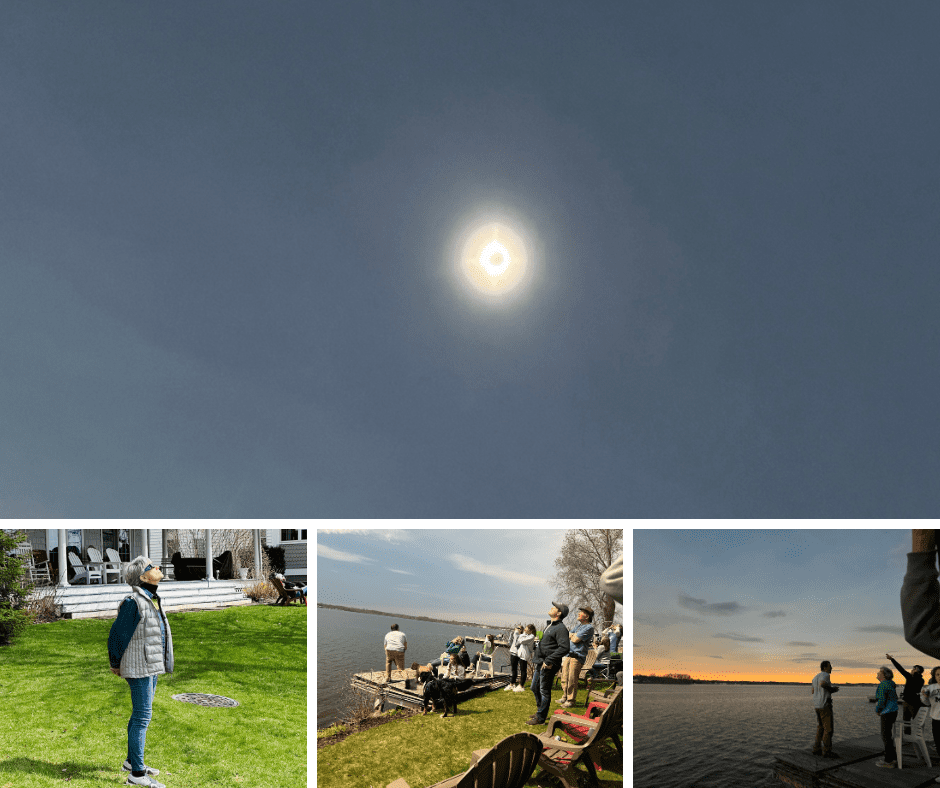
My husband and I are on the shores of Lake Conneaut, the largest natural lake in the state of Pennsylvania. We’re meeting for the first-time, relatives and friends of our Pittsburgh neighbors who share a century old summer cottage on the lake. We’ve driven several hours to this place, which is close to the center of the path of totality, to view the 2024 eclipse. It wasn’t a certainty we would make it in time since I had a morning doctor’s appointment I couldn’t reschedule. The doctor’s next available appointment is late fall.
First contact has already begun as we arrive. We’re invited to occupy one of the green plastic Adirondack chairs facing the lake and the panoramic view of the in and out sun and cloud filled sky. Children and dogs scamper about while our hosts make sure we meet everyone, know where the snack table is and how to find the rest rooms.
Now several days later we can ask, and perhaps answer, the questions the experience generated. What did we learn and was it worth it? Was it worth the advance planning to secure protective glasses, interrupt our normal Monday schedule to travel throughout the countryside and back on alternating traffic filled roads –all to view for a few minutes the shadow of the moon slowly, eventually, covering the sun?
“One half the people cry when they see it,” a 40s something man says as we all struggle with our glasses to see a clear image of what’s happening in the sky dance of sun, moon, and clouds. “Is anyone crying?” he asks and members of the viewing group laugh at this notion. I place my hands over my ears to block the distraction as this theme repeats–“How about now? Is anyone crying yet?” Again, more laughter and occasionally people pretending to cry. “No fake crying, the man declares. It has to be real.”
I agree with the man that tears must be real. As a grief advocate it is difficult for me to experience people’s confusion and shame around tears, their own and other peoples. When tears occur in circumstances like witnessing an eclipse, they are not necessarily tears of sadness. They can be an expression of awe and the body’s signal to pay attention. What’s occurring really matters.
Author Dacher Keltner in his book “Awe: The New Science of Everyday Wonder and How it Can Transform Your Life defines the feeling of awe as “being in the presence of something vast that transcends your current understanding of the world.”
The 2024 eclipse is transforming our understanding of the sun, especially for the scientist that are studying it. Each eclipse furthers their understanding of the sun’s dynamic motion. We saw with our naked eyes a bright red dot shooting out from the lower left edge of the solar circle and recognized it as a solar flare. If we hadn’t watched the NOVA show on Eclipses a few nights before we might have missed this idem and for sure, we wouldn’t have known what to call it.
Viewing news broadcasts of interviews with people from around the country I noted that it was important who accompanied or surrounded them during the experience. Parents expressed joy at being able to share the event with their children, mentioning it would be a memory and milestone to connect them later. Kids of all ages meanwhile seemed to revel in the celebratory party atmosphere, recognizing this was an important occasion. For some people, it was the reminder of and connection to loved ones no longer here. For one man, the event pointed to his own mortality – “I’m not likely to be here for the next one, so I thought I should go to this one.” Several people mentioned appreciating the viewing party as a community event that brought people together across the conflictual political and cultural divides of our time. Most everyone’s reaction seemed to demonstrate another of Keltner’s definitions of awe – “Tears of awe signal an awareness of vast things that unite us with others.” It seems it’s the connection to vastness that transforms the ordinary into the memorable and never forgotten extraordinary.

